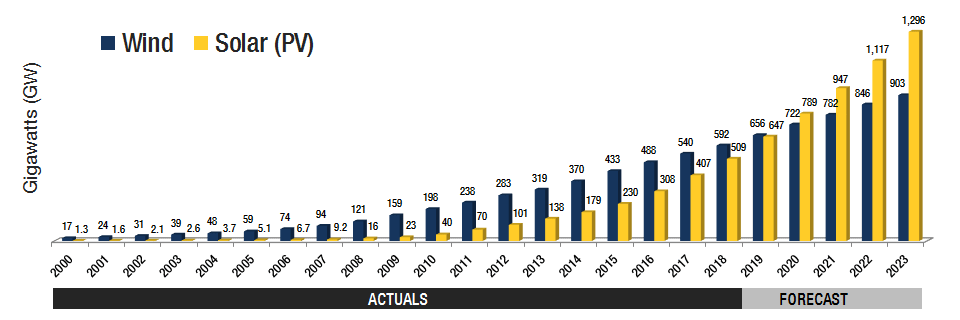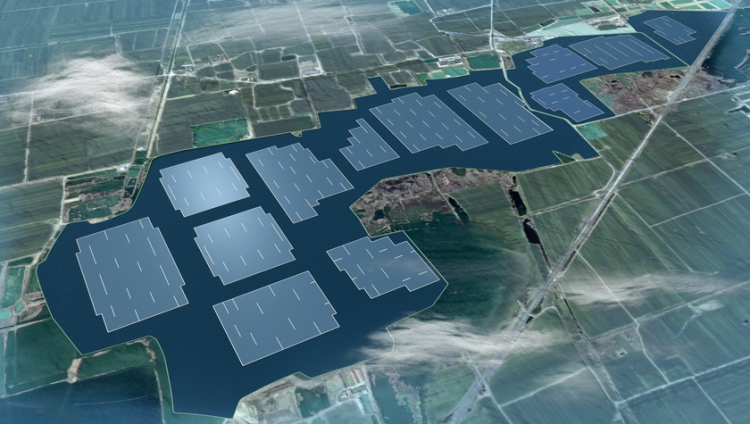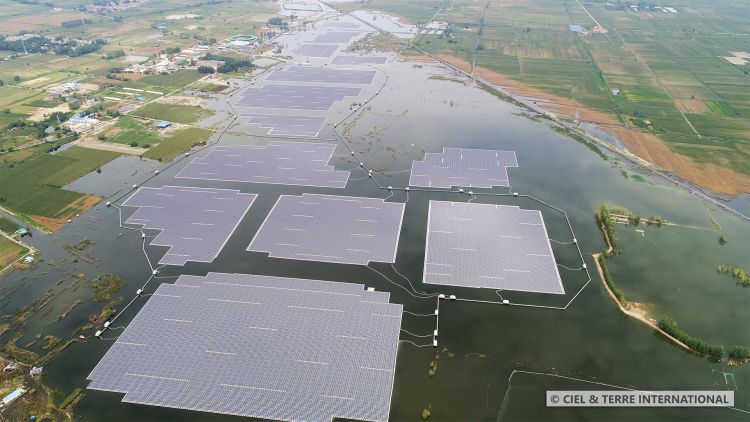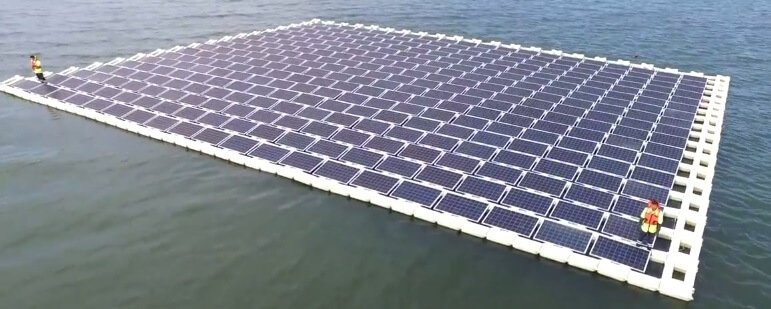Floating Solar Energy Systems 1

In the first article of this year, I decided to consider a technical issue. I will include these technical articles whenever I have the opportunity. Today, I will talk about a different model that the public is not aware of but is increasing its popularity in the solar energy industry every day: Floating Solar Energy Systems.
The English equivalent of these systems, which we call "Floating GES" for short, is "Floating Solar Energy Systems" or "Floating Solar" for short.
Since I want to deal with this issue in many different aspects, I will devote two articles to the Floating GES. This first article will be more introductory where I will introduce you to the concept and provide versatile assessments of Floating GES’s. In the second article, I will go into the technique of the work and give more details in this respect.
The “replacement of fossil fuels by renewable energy”, the most important element of the energy revolution, continues unabated. Thanks to greenhouse gas reduction and climate policies, which are supported by almost all countries worldwide, solar energy technologies are leading the way with wind energy to get rid of fossil fuels. In the image below, you can see this trend that has been going on since the beginning of the 21st century.

Source: Forecast International’s Energy Portal: http://www.fi-powerweb.com/Renewable-Energy.html
It is inevitable that solar energy installations are becoming more and more widespread. Because solar energy has the technology and equipment to support both central systems and distributed systems models. In this sense, solar installations are rapidly increasing in both power plants and on-site installations that provide on-site consumption.
On the other hand, we are witnessing many different models other than classical power plant and rooftop applications. In this article, I will include the concept of Floating GES’s, whose popularity in the sector is increasing and we are witnessing that their installations are becoming widespread.
Although the history of solar panels extends over a hundred years, Floating GES’s have only been used for about 10 years. To be more specific, the first commercial Floating GES was established in 2006 in a vineyard in California, USA. Although other Floating GES’s were installed in Japan, France and India in the same year, all of them were experimental systems.
The purpose of the system, which was installed on the irrigation canal in the vineyard in California, was primarily to expand the solar panel system mounted to the existing location without sacrificing the area to be planted. The energy consumption of the vineyard was reset thanks to this solar powered system, which was completed with the installation of 1,000 floating panels of 175 kW in total. In addition, extra grapes were planted on 3 hectares of land, which would normally be covered with solar panels, to produce 150,000 dollars of wine crops per year.
A widespread expansion due to an incentive
Although its first commercial example was launched in 2006, almost no other floating solar panel system was installed until 2013. However, after the FIT (Feed in Tariff) mechanism was launched in 2012 after the Fukushima disaster in 2011 in Japan, Floating GES installations began to spread with other countries providing similar incentives. As the incentive (FIT) applied to Floating GES in Japan at that time was an astronomical figure of 53.4 Cent / kWh, until the end of 2013, only 45 new installations were completed in Japan. Since 2013, the Floating GES installed capacity has continued to increase exponentially. For example; while 1.18 MW was installed worldwide in 2013, this number increased to 4.9 MW in 2014, 34.6 MW in 2015, 53 MW in 2016, and the total installed worldwide as of September 2018 capacity reached 1.1 GW. (Solar Energy Research Institute of Singapore SERIS).
The incentive mechanisms offered by countries after the rapid widespread of Floating GES, saw turnkey solar system prices dropping rapidly and the efficiency of PV panels increased continuously, offering advantages that no other solar system had. Creating a new area by using the water surface, which would normally be considered as an idle area, and to bring in very large areas such as over the dam, above the sea, above the lake, above the water channel to the solar energy was seen as a great advantage.
The advantages of Floating GES’s
For example, as in the example of Japan I just gave, an island country with an area of 377.973 m² has a population of over 125 million people. This means that the spaces are limited. It is a natural result that Japan, which is an island country, focuses on the floating power plant system due to the fact that there is an increasing awareness of renewable energy after the Fukushima disaster. It is very logical to use the Pacific Ocean, which rotates the Japanese islands from all sides, as an additional area for Floating GES’s.
Moreover, the area covered with floating solar panels can reduce evaporation by up to 80% by protecting it from sunlight. In this way, it is possible to decrease the water level in the dams more slowly, to carry more water in the irrigation channels and to provide extra energy to the water treatment plants. Another important feature of this system is that the floating factor of the floating solar panel system which is 7.6% to 13.5% higher than a solar system installed anywhere on the land (when the same technology is used). (Young-Kwan Choi, 2014) The reason for this is that the panels work more efficiently at low temperatures and that the water is a natural cooler.
Other advantages of Floating GES’s are that, since there is no expropriation costs, the investment costs are lower, since it prevents sun rays, it reduces the algae growth in stagnant waters and keeps the water clean, and it can be installed faster thanks to its modular structure and the need to lay a foundation on the ground.
The disadvantages are like a drop in a bucket
In addition to all these features, this system has some minor disadvantages. For example, electricity production is slightly more unstable than other systems, since it is exposed to hydraulic and weather conditions much more than other solar systems. In addition, no matter how durable and harmless the floating equipment is made of nature, water is likely to erode the system and shorten the life of the system over time. There are also differences between the effects of saltwater and fresh water. The wearing rate is higher especially in the installations made above sea.
Finally, depending on its location, it may prevent some fishing and transportation activities. However, this is also relative. In other words, it can be wandered around any floating power plant under normal conditions.
Considering its advantages, these cons are only like a drop in a bucket. Because the installation on the water not only increases the efficiency of the panel, saves the floor, but also prevents the evaporation of the water, thus providing a great advantage in every sense.
The largest floating GES, which has been officially accepted and started supplying electricity to the grid, was established in China by the government owned CECEP company in Anhui, a former coal production region. The total installed power of the system is 70 MW and it has been implemented in cooperation with the French Ciel-et-Terre, the world's largest floating solar panel technology and EPC company.

70 MWp floating power plant complex in China: CECEP
On the other hand, a floating GES with an installed capacity of 150 MW is installed in the same reservoir by Three Gorges New Energy, a Chinese company, and some of them are already connected to the grid. After this project is completed, the world's largest floating solar panel system will now belong to Three Gorges New Energy.

Floating power plant built on Three Gorges Dam in Anhui (China)
As an example of floating plants, we witness some wonderful initiatives in our country. TYT (Clean Creative Technologies) firm founded by young people is the leader in this regard. In the Young Guru Academy (YGA) leadership is Baris Arici, Cemil Cihan Özalevli and Bilal Tasci who are the founders advancing with firm steps to set up in different places in Turkia by signing this company's worth recognition: https://www.tyt.com.tr/

A visual of the floating power plant built by TYT for İBB (Istanbul Metropolitan Municipality) on the Büyükçekmece lake in Istanbul.
Personally, I am very pleased with the work and achievements of young people who have a proper character and who want to make a difference. Good luck, young people!
Although it officially started in 2006, it seems that the rise of Floating GES’s, which I have stated accelerated after 2013, will continue to increase. According to a market analysis by Credence Research, while the Floating GES market value in 2016 was only $ 0.16 billion, this number will reach 1.6 billion by 2022. This means that the Floating GES market will continue to grow at an annual rate of 113.9%. How fast and for how long this growth will continue will change in direct proportion with the policies of the future, our speed of technological progress and our desire to get rid of fossil fuels. I wish the same for the head of our country and all countries.
Hybrid regulations are expected to be issued in our country in the near future. The sector expects regulation to come out this year. If this is achieved, then it is possible to observe a serious increase in HEPP + GES hybrid power plants. We wish for the best…
Increasing applications of floating power plants and many other renewable energy models is critical for leaving a world without concern for climate change to new generations.
We’ll discuss this furthermore in my next technical article about Floating GES. Till then, take care.
References:
- https://www.pv-tech.org/news/worlds-largest-floating-solar-plant-connected-in-china
- https://www.worldbank.org/en/news/press-release/2018/10/30/floating-solar-opens-new-horizons-for-renewable-energy
- https://www.researchgate.net/publication/321461989_The_global_evolution_of_floating_solar_PV
Tag: enerji









